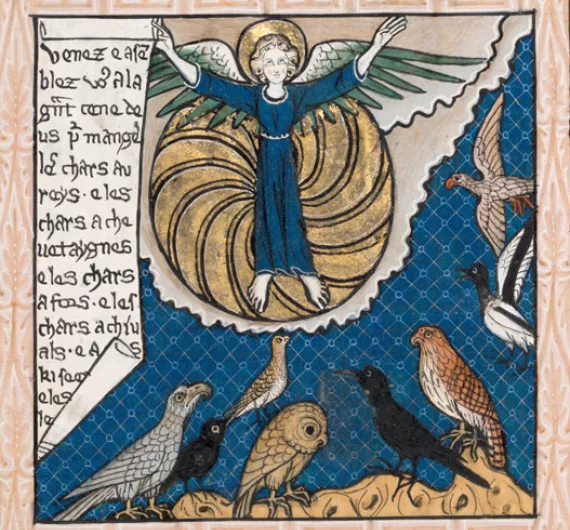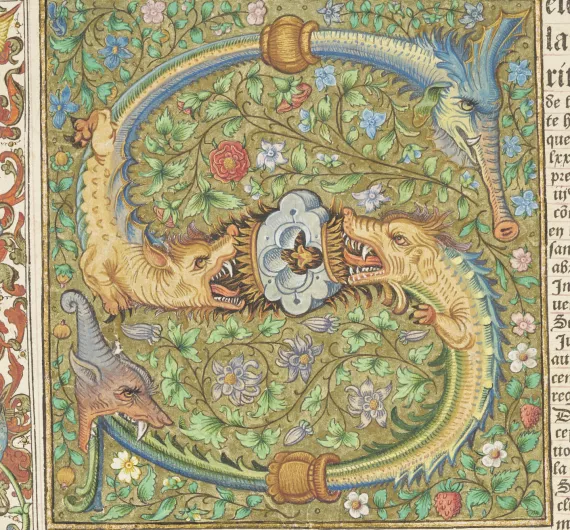Our videos will be published over coming terms, building into a collection which will remain here for you to enjoy.
- Our collections of manuscripts, archives, and rare books are famous the world over, with our earliest manuscript and archive treasures dating from the 11th century.
- More manuscripts survive from the medieval library of New College than from that of any other Oxford or Cambridge college, and we hold what is probably the finest collection of medieval manuscripts of any of the Oxford colleges.
- Our archives contain evidence of college endowment, administration, and finance from the outset, and our earliest documents are 11th-century title deeds.
- New College Library holds more incunabula (fifteenth-century European imprints) than any other undergraduate college at Oxford, and a very rich collection of other early printed books.
- Greek Book of Prophets (early 13th century), New College Library, Oxford, MS 44
- Anglo-Norman Apocalypse (1300–1310), New College Library, Oxford, MS 65
- John Gower, Confessio Amantis (c. 1400–1425), New College Library, Oxford, MS 266
- Wycliffite Psalms (mid-15th century), New College Library, Oxford, MS 320
- Dutch Book of Hours (1460–1480), New College Library, Oxford, MS 371
- Bernard André, Annales (1515), New College Library, Oxford, MS 287
- Donations Book of Bishop Robert Sherborn (c. 1531), New College Archives, Oxford, NCA 9432
- Sebastian Münster, Cosmographia (1544), New College Library, Oxford, BT3.187.1(2)
- Hermann von Wied, Simplex et pia deliberatio (c. 1545), New College Library, Oxford, MS 136
- Tudor Wardrobe Warrants (1550–1558), New College Library, Oxford, MS 328
- Christopher Saxton, Atlas of the Counties of England and Wales (1579), New College Library, Oxford, BT1.47.9
- Thomas Powell, ‘The Visions of William Collins’ (1792), New College Library, Oxford, MS 367
Greek Book of Prophets (early thirteenth century), MS 44
This luxurious manuscript is a volume of Old Testament books of the Minor Prophets, written in Greek, and most likely produced at Constantinople (modern Istanbul) or in Cyprus.
John Gower, Confessio Amantis (c. 1400–1425), MS 266
This is one of forty-nine surviving medieval manuscript copies of John Gower’s 33,000-line poem, written in Middle English and Latin, Confessio Amantis (c. 1400–1425) or ‘Lover’s Confession’. Our MS 266 is remarkable because it is one of only two which contain (or once contained) full cycles of illustrations: miniatures illustrating the short narratives.
Wycliffite Psalms (mid-15th century), MS 320
This manuscript is bound before a portion of William Caxton’s The Golden Legend (Westminster: Wynkyn de Worde, 8 Jan. 1498[/99?]), hitherto unreported. Two Latin prayers conclude the manuscript, and at the end of the writing there is ‘By William Huchen’ in the red ink of the rubrication, showing that the writing and decoration were done by the same man.
Dutch Book of Hours (c. 1460–1480), MS 371
Written in the Middle Dutch vernacular, this manuscript book of hours was likely made in a monastery, and it is one that we know was owned by women.
Bernard André, Annales (1515), MS 287
This manuscript is a royal presentation copy, produced for its (blind) author the Tudor court poet Bernard André, and intended as André’s New Year’s Day gift for King Henry VIII in 1515. Its beautiful, illuminated shell-gold initial ‘C’ is decorated with a Tudor rose in white and red with a gold crown above, in honour of the king.
Donations Book of Bishop Robert Sherborn (c. 1531), NCA 9432
This volume contains copies of charters creating the Wiccamical prebends in Chichester Cathedral, and also the free grammar school at Rolleston, Staffordshire, with lists of jewels and ornaments, an estate rental and benefactions to New College, St Frideswide’s monastery, Oxford (now Christ Church), and Lambourne, Berkshire.
Hermann von Wied, Simplex et pia deliberatio (c. 1545), MS 136
The first part of this volume is an incomplete manuscript translation into Latin, by King Henry VIII’s librarian Wouter Deleen, of the German printed book which follows it, Hermann von Wied’s Einfältiges Bedenken, worauf eine christliche, im Worte Gottes gegründete Reformation . . . anzurichten sei (Bonn: Laurenz von der Mülen, 1543). The whole is bound into a spectacular gold-tooled binding, by the so-called Flamboyant Binder, intended for the library of Henry VIII.
Tudor Wardrobe Warrants (1550–1558), MS 328
This collection of royal state documents was given to the college in 1710 by a fellow, the Revd John Woodford. It is largely composed of official wardrobe warrants, documents which were issued by the reigning monarch to their Keeper of the Wardrobe. They were issued principally by King Edward VI and Queen Mary I, but they also include extraordinary rarities: two signed by Lady Jane Grey, as Queen Jane.
Saxton, Atlas of the Counties of England and Wales (1579), BT1.47.9
Produced in 1579, this is the first atlas created of any country. It contains 35 maps, all bearing the arms of Elizabeth I and Thomas Seckford, Christopher Saxton’s patron. Our copy was first owned by John Savile, the older brother of the Elizabethan scholar and courtier Sir Henry Savile, who founded the Savilian Professorships in Geometry and Astronomy, both of which are attached to New College.
Thomas Powell, ‘The Visions of William Collins’ (1792), MS 367
One of the most recent manuscripts acquired by New College Library, arriving in the late twentieth century, the poem of MS 367 is attributed on its title-page to Thomas Powell (1735–1820), poet and playwright, whose published works appear both under his own name and under his long-standing pseudonym, ‘Il Taliessen de Monmouth’.
Discover more about New College




